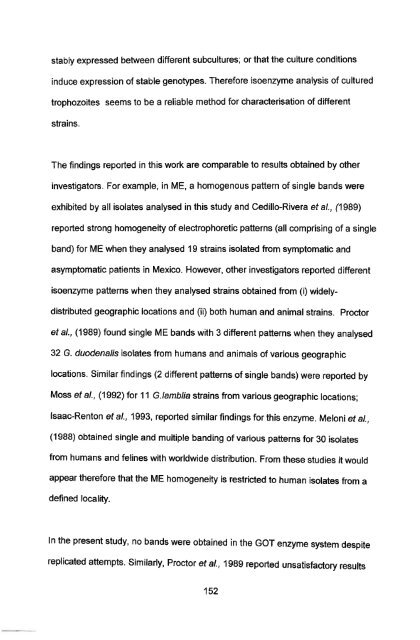in vitro culture and isoenzyme analysis of giardia lamblia
in vitro culture and isoenzyme analysis of giardia lamblia
in vitro culture and isoenzyme analysis of giardia lamblia
You also want an ePaper? Increase the reach of your titles
YUMPU automatically turns print PDFs into web optimized ePapers that Google loves.
stably expressed between different sub<strong>culture</strong>s; or that the <strong>culture</strong> conditions<br />
<strong>in</strong>duce expression <strong>of</strong> stable genotypes. Therefore <strong>isoenzyme</strong> <strong>analysis</strong> <strong>of</strong> <strong>culture</strong>d<br />
trophozoites seems to be a reliable method for characterisation <strong>of</strong> different<br />
stra<strong>in</strong>s.<br />
The f<strong>in</strong>d<strong>in</strong>gs reported <strong>in</strong> this work are comparable to results obta<strong>in</strong>ed by other<br />
<strong>in</strong>vestigators. For example, <strong>in</strong> ME, a homogenous pattern <strong>of</strong> s<strong>in</strong>gle b<strong>and</strong>s were<br />
exhibited by all isolates analysed <strong>in</strong> this study <strong>and</strong> Cedillo-Rivera et al., (1989)<br />
reported strong homogeneity <strong>of</strong> electrophoretic patterns (all compris<strong>in</strong>g <strong>of</strong> a s<strong>in</strong>gle<br />
b<strong>and</strong>) for ME when they analysed 19 stra<strong>in</strong>s isolated from symptomatic <strong>and</strong><br />
asymptomatic patients <strong>in</strong> Mexico. However, other <strong>in</strong>vestigators reported different<br />
<strong>isoenzyme</strong> patterns when they analysed stra<strong>in</strong>s obta<strong>in</strong>ed from (i) widelydistributed<br />
geographic locations <strong>and</strong> (ii) both human <strong>and</strong> animal stra<strong>in</strong>s. Proctor<br />
et al., (1989) found s<strong>in</strong>gle ME b<strong>and</strong>s with 3 different patterns when they analysed<br />
32 G. duodena/is isolates from humans <strong>and</strong> animals <strong>of</strong> various geographic<br />
locations. Similar f<strong>in</strong>d<strong>in</strong>gs (2 different patterns <strong>of</strong> S<strong>in</strong>gle b<strong>and</strong>s) were reported by<br />
Moss et al., (1992) for 11 G.<strong>lamblia</strong> stra<strong>in</strong>s from various geographic locations;<br />
Isaac-Renton et al., 1993, reported similar f<strong>in</strong>d<strong>in</strong>gs for this enzyme. Meloni et al.,<br />
(1988) obta<strong>in</strong>ed s<strong>in</strong>gle <strong>and</strong> multiple b<strong>and</strong><strong>in</strong>g <strong>of</strong> various patterns for 30 isolates<br />
from humans <strong>and</strong> fel<strong>in</strong>es with worldwide distribution. From these studies it would<br />
appear therefore that the ME homogeneity is restricted to human isolates from a<br />
def<strong>in</strong>ed locality.<br />
In the present study, no b<strong>and</strong>s were obta<strong>in</strong>ed <strong>in</strong> the GOT enzyme system despite<br />
replicated attempts. Similarly, Proctor et al., 1989 reported unsatisfactory results<br />
152
















